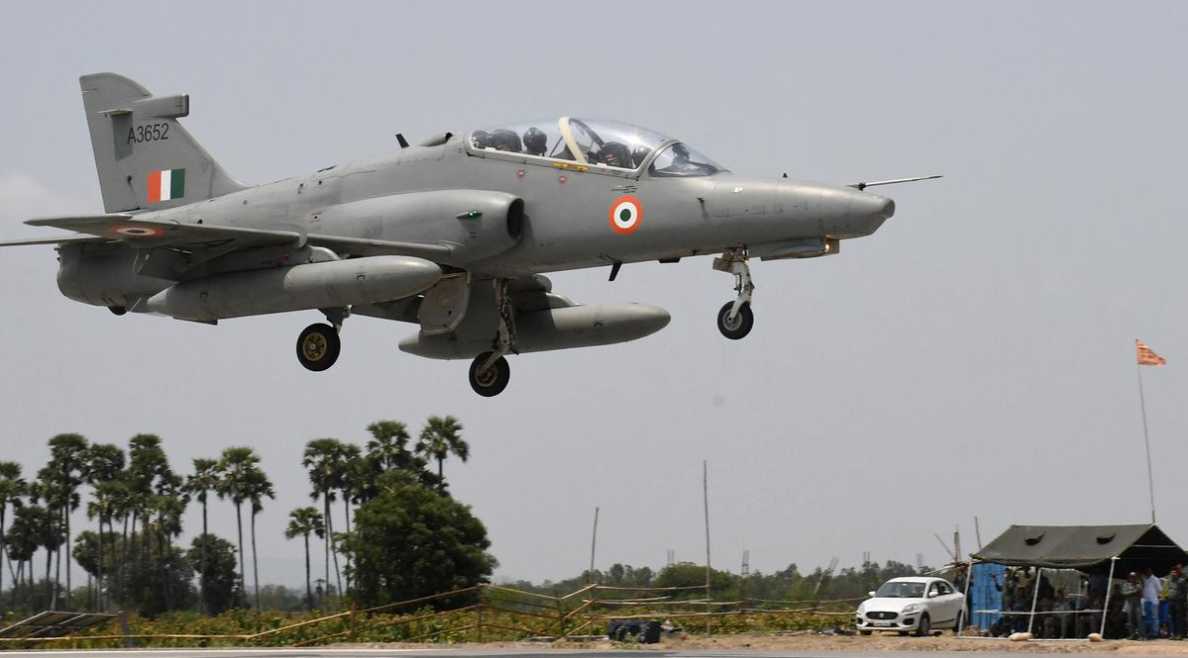Introduction
IAF Fighter a surprising and concerning incident, an Indian Air Force (IAF) fighter jet “inadvertently” released an “air store” during a routine training mission near Pokhran, Rajasthan. The event, which occurred recently, has triggered a high-level inquiry by the IAF to understand the circumstances and implications of this unintended release. While the IAF has confirmed the incident and the subsequent investigation, it has not disclosed the specific nature of the “air store” involved, leading to widespread speculation and concern about potential risks and safety issues.
This article aims to provide an in-depth analysis of the incident, exploring the possible nature of the “air store,” the implications for the IAF’s operational procedures, and the broader impact on public safety and military transparency. It will also examine the context of such incidents within the framework of military training and preparedness, as well as the potential lessons that can be learned to prevent future occurrences.
The Incident: What We Know So Far
On a routine training mission near Pokhran, a region known for its historical significance as a nuclear test site, an IAF fighter jet accidentally released what has been termed an “air store.” The term “air store” typically refers to any equipment, munition, or payload carried by an aircraft, including bombs, missiles, fuel tanks, or other devices used for training or combat purposes. The release of such a store during flight, especially in a non-combat scenario, is highly unusual and has raised several questions.
The IAF, in its official statement, acknowledged the incident and confirmed that no casualties or significant damage occurred as a result of the release. However, the statement was deliberately vague regarding the specifics of the “air store,” leaving room for speculation. The incident occurred in close proximity to the Pokhran testing range, an area frequently used by the IAF for training exercises due to its isolated location. 
Understanding the “Air Store”
While the IAF has not disclosed the exact nature of the “air store,” it is essential to understand what this term generally encompasses. An “air store” can refer to any external payload that an aircraft carries, including:
- Missiles: Air-to-air or air-to-ground missiles used for combat.
- Bombs: Various types of bombs, including practice bombs used in training.
- External Fuel Tanks: Additional fuel storage to extend the range of the aircraft.
- Pods: Electronic warfare pods, reconnaissance pods, or targeting pods.
- Countermeasures: Flares or chaff used to evade enemy radar or missiles.
Given that the incident occurred during a training mission, it is possible that the “air store” could have been a practice bomb or a non-lethal payload designed for training purposes. However, without official confirmation, the exact nature of the “air store” remains speculative.
The Significance of Pokhran
Pokhran, located in the Thar Desert of Rajasthan, holds a special place in India’s military history. It was the site of India’s first successful nuclear test in 1974 and subsequent tests in 1998. The area is now a designated test range used by the Indian Armed Forces for various training exercises, including live-fire drills and weapon system testing.
The proximity of the incident to Pokhran adds an additional layer of sensitivity, given the area’s association with India’s strategic capabilities. The use of this region for training exercises is not uncommon, but any unintended release of military equipment in such a significant location naturally attracts attention and concern.
The IAF’s Response and Investigation
Following the incident, the IAF promptly ordered a high-level inquiry to investigate the cause of the inadvertent release. The inquiry is expected to examine several aspects, including:
- Technical Malfunction: Investigating whether a mechanical or software failure caused the unintended release.
- Pilot Error: Assessing if human error or a lapse in standard operating procedures contributed to the incident.
- Safety Protocols: Reviewing the safety measures in place during training exercises to prevent such occurrences.
- Operational Impact: Evaluating the broader impact on IAF operations and whether any changes to training protocols are necessary.
The IAF has a robust system for investigating such incidents, with the aim of identifying the root cause and implementing corrective measures to prevent future occurrences. The outcome of the inquiry will likely lead to recommendations for improvements in both equipment handling and operational procedures.
Potential Risks and Public Safety Concerns
The inadvertent release of an “air store” carries inherent risks, both to the immediate environment and to public safety. Although the IAF has confirmed that no casualties or significant damage occurred, the potential for harm in such incidents cannot be overlooked. Depending on the nature of the “air store,” the risks could include:
- Explosive Hazards: If the “air store” was a live munition, the risk of an unintended detonation could have posed a significant threat to nearby populations or infrastructure.
- Environmental Impact: The release of certain types of munitions or fuel tanks could have environmental consequences, particularly in sensitive areas like the Thar Desert.
- Public Perception: Incidents like this can erode public confidence in the safety and reliability of military operations, particularly when information is not fully disclosed.
The IAF’s decision to withhold specific details about the “air store” has led to speculation and concern among the public. While operational security and confidentiality are important, maintaining transparency to the extent possible is crucial in addressing public concerns and maintaining trust in military operations.
Historical Context of Similar Incidents
While rare, incidents involving the unintended release of military equipment are not entirely unprecedented. Militaries around the world have occasionally faced similar situations, often during training exercises or routine operations. Some notable examples include:
- United States: In 2018, a U.S. Air Force fighter jet accidentally released a training munition over South Korea during a routine exercise. The incident led to an investigation, and no injuries were reported.
- Russia: In 2017, a Russian fighter jet accidentally dropped a bomb over a civilian area during a training exercise in the Arctic region. Fortunately, the bomb was a dud, and no casualties occurred.
- India: In 2015, an Indian Air Force MiG-27 fighter jet jettisoned its external fuel tank during takeoff from a base in West Bengal. The tank landed in a field, causing a fire but no casualties.
These incidents underscore the importance of rigorous safety protocols and the need for continuous monitoring and improvement of military procedures to minimize the risk of unintended releases.
The Role of Military Training and Preparedness
Training exercises are a vital component of military preparedness, allowing armed forces to hone their skills, test new equipment, and ensure operational readiness. However, such exercises also carry inherent risks, particularly when live munitions or sensitive equipment are involved. Balancing the need for realistic training with the imperative of safety is a constant challenge for militaries worldwide.
The IAF, like other military forces, conducts regular training exercises to maintain the combat readiness of its pilots and equipment. These exercises often involve complex maneuvers and the use of various munitions, making the implementation of stringent safety protocols essential. The incident near Pokhran serves as a reminder of the potential risks involved and the need for continuous vigilance.
The Implications for the Indian Air Force
The inadvertent release of an “air store” during a training mission has several implications for the IAF, both in terms of operational procedures and public perception. Key considerations include:
- Operational Review: The IAF may need to conduct a comprehensive review of its training protocols and equipment handling procedures to identify any gaps that could lead to similar incidents in the future.
- Pilot Training: Enhancing pilot training on the safe handling of munitions and other equipment, particularly during high-stress or complex maneuvers, will be crucial in preventing accidental releases.
- Equipment Maintenance: Ensuring that all aircraft systems, particularly those related to the release of stores, are regularly inspected and maintained to prevent technical malfunctions.
- Public Communication: The IAF may need to reassess its communication strategy, balancing the need for operational security with the public’s right to information. Transparent communication can help mitigate concerns and maintain public trust.
Lessons Learned and the Path Forward
While the incident near Pokhran was fortunately without casualties or significant damage, it provides valuable lessons for the IAF and other military organizations. Key takeaways include:
- The Importance of Rigorous Safety Protocols: Ensuring that safety protocols are continuously updated and rigorously enforced is essential in preventing unintended releases of military equipment.
- Continuous Training and Simulation: Incorporating advanced simulation techniques in pilot training can help prepare pilots for complex scenarios without the risks associated with live exercises.
- Regular Equipment Audits: Conducting regular audits of aircraft systems and munitions handling equipment can help identify potential issues before they lead to accidents.
- Enhanced Public Communication: Developing a communication strategy that provides sufficient information to the public while maintaining operational security can help alleviate concerns and maintain trust.
- International Cooperation: Sharing best practices and lessons learned from similar incidents with international partners can contribute to global military safety standards.
Conclusion
The inadvertent release of an “air store” by an IAF fighter jet near Pokhran serves as a stark reminder of the complexities and risks associated with military training exercises. While the incident did not result in casualties or significant damage, it has prompted a high-level inquiry and raised important questions about safety, transparency, and public trust.
As the IAF conducts its investigation, the focus will likely be on identifying the root cause of the incident and implementing measures to prevent future occurrences. The lessons learned from this incident will not only contribute to the IAF’s operational readiness but also serve as a valuable reference for militaries worldwide. ALSO READ:- More Graduates, Fewer Relevant Jobs: The Underlying Factor Behind Bangladesh Protests 2024





